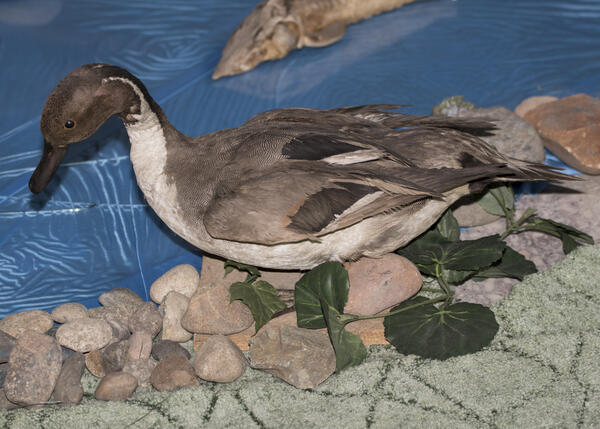The pintail or northern pintail is one of the most widespread and populous members of the water bird family. The distinguishing characteristic of the male species is its pin-shaped tail.
Among hunters, these birds are viewed as a highly desirable target, but they are hard to kill. The pintail flies low and fast, hence only agile hunters that are good shots can wound or kill it. In addition, unlike other ducks, this bird takes off from the water practically without preliminary preparation. And its ability to perform complicated maneuvers in the air could make many other birds envious.
The pintail lives in open spaces and avoids forested regions. Water bodies with abundant vegetation, particularly in arctic and subarctic tundra, appeal to it. In southern parts of its natural habitat, the bird inhabits forest steppes near average-sized lakes, rivers, swamps and wetlands.
In the air, gyrfalcons pose the biggest threat to pintails, while on the ground, northern goshawks do. Red foxes and lynxes quite often sneak up on pintails in their nests, which have no chance of escaping once these predators get close.
These birds mainly feed on aquatic plants. Typically, they eat in the mornings and evenings, and rest in the afternoons. Their main food sources are seeds and rhizomatous herbs. Pintails search for food on the ground quite infrequently, with roots or various grains providing enough sustenance. They also fly to cultivated fields and treat themselves to some wheat, rye, buckwheat and rice.
During the period when the female pintail lays and incubates its eggs, it actively eats animal-based foods that can account for 60 to 80% of its daily diet, which includes larvae of aquatic insects, shell-fish, amphipods and earthworms.
Pintails find partners in places they migrate to for the winter. In December and January, males gather into flocks for the courtship season. They try to attract the attention of females by raising wings and tilting their heads onto their backs, while, at the same time, moving their bills along the feathers and generating chattering noises. Two birds then partner up for the season during a low flight with each other.
Only the female pintail is responsible for building the nest. It digs out a hole in the ground and lines its insides with dry grass, leaves and downy feathers. Its partner does not help to incubate the eggs but, initially, it remains near the nest. If the male notices an approaching predator, it draws its attention onto itself, thus allowing the partner to escape. Even if a clutch is destroyed, the female pintail can lay eggs again before the end of July.
The incubation period lasts for 22-24 days. The mother then takes its hatchlings to the nearest water body. The offspring feed on insects that they catch on the water surface. In the wild, the pintail rarely lives until the age of 6 to 8. In captivity, under suitable conditions, its lifespan can reach 20 years. A record was set by one of these birds that lived until the age of 27 years and 5 months.
Among hunters, these birds are viewed as a highly desirable target, but they are hard to kill. The pintail flies low and fast, hence only agile hunters that are good shots can wound or kill it. In addition, unlike other ducks, this bird takes off from the water practically without preliminary preparation. And its ability to perform complicated maneuvers in the air could make many other birds envious.
The pintail lives in open spaces and avoids forested regions. Water bodies with abundant vegetation, particularly in arctic and subarctic tundra, appeal to it. In southern parts of its natural habitat, the bird inhabits forest steppes near average-sized lakes, rivers, swamps and wetlands.
In the air, gyrfalcons pose the biggest threat to pintails, while on the ground, northern goshawks do. Red foxes and lynxes quite often sneak up on pintails in their nests, which have no chance of escaping once these predators get close.
These birds mainly feed on aquatic plants. Typically, they eat in the mornings and evenings, and rest in the afternoons. Their main food sources are seeds and rhizomatous herbs. Pintails search for food on the ground quite infrequently, with roots or various grains providing enough sustenance. They also fly to cultivated fields and treat themselves to some wheat, rye, buckwheat and rice.
During the period when the female pintail lays and incubates its eggs, it actively eats animal-based foods that can account for 60 to 80% of its daily diet, which includes larvae of aquatic insects, shell-fish, amphipods and earthworms.
Pintails find partners in places they migrate to for the winter. In December and January, males gather into flocks for the courtship season. They try to attract the attention of females by raising wings and tilting their heads onto their backs, while, at the same time, moving their bills along the feathers and generating chattering noises. Two birds then partner up for the season during a low flight with each other.
Only the female pintail is responsible for building the nest. It digs out a hole in the ground and lines its insides with dry grass, leaves and downy feathers. Its partner does not help to incubate the eggs but, initially, it remains near the nest. If the male notices an approaching predator, it draws its attention onto itself, thus allowing the partner to escape. Even if a clutch is destroyed, the female pintail can lay eggs again before the end of July.
The incubation period lasts for 22-24 days. The mother then takes its hatchlings to the nearest water body. The offspring feed on insects that they catch on the water surface. In the wild, the pintail rarely lives until the age of 6 to 8. In captivity, under suitable conditions, its lifespan can reach 20 years. A record was set by one of these birds that lived until the age of 27 years and 5 months.



